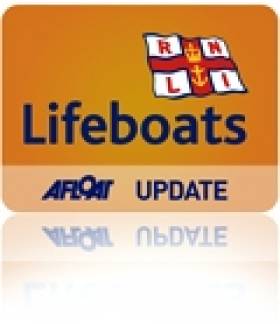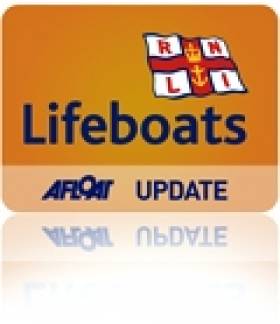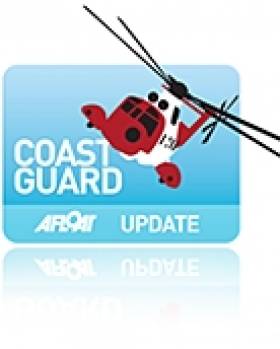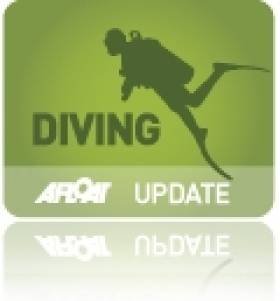Displaying items by tag: Baltimore
Baltimore Maritime Centre to Expand West Cork Sailing Courses in 2015
#baltimore – BMC/Glenua was formed in 2013, in order to continue the sailing activities of Les Glénans in Baltimore, West Cork, and we have now completed our first season in operation writes Chairman Michael O'Meara.
Baltimore Maritime Centre ran a limited number of residential keelboat courses in Heir Island, adjacent to Baltimore, using a fleet of Glénans 570s. The courses proved to be a great success, with excellent on-shore facilities provided by John Moore of Heir Island Sailing School, a new and exciting sailing area and easy access for sailing in-company to the other islands in Long Island Bay. We also ran a limited number of cruising courses between Kinsale and Baltimore using a chartered Hanse 360 from Sovereign Sailing.
For 2015 we are expanding our residential courses in Heir Island and will have 7 day, 5 day and weekend courses in June, July, August and September. We will run 4 cruising courses in July and August out of Baltimore. The 2015 Sailing Programme is included in our latest newsletter.
The Baltimore and Collanmore bases are still for sale by Fáilte Ireland with some modest offers standing on the Baltimore premises. The West Cork Maritime Heritage Company has been formed in Baltimore with a view to raising funds to make an offer for the old railway station property. If this is successful the property would be developed and used for sail training, traditional boat building, maritime archaeology courses and become the location of a maritime heritage data base. BMC/Glenua would then have the possibility of becoming part of a new and exciting multi purpose maritime centre for the West Cork region.
Attached is a copy of our latest member's newsletter, The Beacon.
Fair winds for 2015,
Michael O'Meara
Chairman
Baltimore Maritime Centre/Glenua
Baltimore Lifeboat Aids Fisherman Overcome With Fumes
#rnli – Baltimore inshore lifeboat was called to give assistance when a medical emergency occurred on board a 75ft fishing vessel in Roaring Water Bay, West Cork last night. The two crew on board had been pumping the vessel bilges with a petrol pump when one of them became overcome with fumes and collapsed. The boat which services mussel rafts in the bay was at her moorings at the time. The casualty was a young man in his late twenties. His fellow crew called for assistance and managed to get him above decks.
The call for assistance was received at Baltimore lifeboat station at 18:51. Weather conditions were very poor at the time, with winds of Force 6 gusting to Force 7 and a sea swell of 1.5 metres. The inshore lifeboat was tasked into service because it could more easily negotiate the mussel rafts strung out along the bay.
Helm Jerry Smith with crew Tadhg Collins and Colin Rochford proceeded through the islands of Roaring Water Bay in pitch darkness in the twin engined Atlantic 75 RIB. When they arrived on scene at 19:30, Schull Community Rescue were already providing medical assistance. The Baltimore lifeboat were able to support efforts to revive the casualty providing essential oxygen.
A Coast Guard helicopter was dispatched to evacuate the young man. He was winched off the deck of the fishing boat at 20:15 and taken to Cork University Hospital.
The inshore lifeboat then returned in worsening weather conditions to the lifeboat station arriving back at 21:30. Crewman Tadhg Collins said, 'it was good to see rescue services working together in a coordinated fashion to ensure the safety of life at sea'.
Baltimore Lifeboat Aids Drifting Fishing Boat
#RNLI - Baltimore RNLI launched within minutes of being alerted to a drifting fishing boat off Yokane Point, west of the Stags in West Cork.
The two men on board the 30-foot motorboat had set out for a peaceful day's fishing on a sunny Autumn afternoon when found themselves in trouble after their engine failed to restart.
But within half an hour of calling for assistance, the Baltimore lifeboat was alongside, with crewman Kieran Collins establishing a tow.
The lifeboat then towed the fishing boat to safety, arriving at Baltimore Harbour at 5.50pm. The motorboat was then secured to the pier by 6.05pm.
Half an hour later the lifeboat returned to station and was ready for service again after essential cleaning and maintenance by 7pm.
On board were coxswain Aidan Bushe, mechanic Cathal Cottrell, Brian McSweeney, Sean McCarthy, Kieran Collins, Micheál Cottrell and RNLI staffer Johnny Clooney.
One Body Recovered, Two Rescued Alive in West Cork Yachting Accident
#westcorkyacht – Two people have been found alive and one body has been recovered after a boating accident off West Cork this morning.
Our photo from the scene taken at dawn this morning show the rescue operation underway with the Coastguard helicopter landing on Horse island, a well known boating spot.
The yacht was discovered shortly after first light this morning, an RNLI spokeswoman said.
RTE News reports the three crew were in a 20-foot yacht that left Schull harbour yesterday afternoon but had not returned by 7pm as expected.
The alarm was raised by a friend who was due to meet them on their return and an air and sea search operation began.
The discovery came after 12 hour search operation when a seven metre yacht (21ft) was reported overdue and missing in Roaringwater Bay in Schull.
A 76-year-old man and the woman, who is in her 60s, were found on a small island known as Castle Island in Schull harbour at 6.15am this morning.
A man's body was found later and is being brought to shore.
They were in need of medical attention and suffering the effects of hypothermia.
The Shannon based Helicopter Rescue 117 lifted the casualties and took them to Baltimore for further medical attention.

Baltimore lifeboat and the Coast Guard Helicopter located the dinghy and two crew on a small island known as Castle Island in Schull harbour at 6.15am this morning. Photo: Judy McGrath
They indicated to their rescuers that the third man had been trying to swim the 100m to shore along with them when they lost contact with him.
The Irish Independent reports the yacht was a Drascombe Lugger, about 20ft long, which was found upturned about one and a half miles from shore near Castle Island. The boats are popular in this area ideal for coastal cruising and conditions in more sheltered parts of the bay are considered ideal for vessels of this kind.
Sources say formal identification of the body and confirmation that the remains are those of the missing sailor will take some time.
Additional report from RNLI Baltimore
Baltimore Lifeboats have been involved in a major search and rescue operation in Roaring Water Bay. Three people were reported missing when a small open sailing boat ( a Drascombe Lugger) failed to return to Schull as planned at 7pm. The Baltimore lifeboats were alerted at 9:14pm on Wednesday 13 August. They immediately began a search of the area between Long Island in the West and Horse Island in the East and extending South through Roaring Water Bay. The lifeboats continued searching as darkness fell until the search was stood down after midnight. The search was recommenced at 5:30 am this morning 14 August. Two people were found by Schull Community Rescue on the NW corner of Castle Island at 6:15 this morning. They were a man in his 70's and a woman in her 60's, both from the UK. Inshore lifeboat Helm John Kearney and crew Ryan O'Mahony carried out a medical assessment of the man and woman who had scrambled ashore the previous evening after their boat had capsized, and then the Shannon based Helicopter Rescue 117 took them to Baltimore for further medical attention. The upturned boat was found aground on the nearby Carthy Islands.
Several hours later inshore lifeboat Helm Youen Jacob with crew John Kearney and Ryan O'Mahony spotted a life jacket in the water North of Sherkin Island. The body of the missing man was recovered at 8:15 approx. The man was taken to the station at Bullpoint where he was pronounced dead by RNLI Medical Advisor Dr Don Creagh. Sergeant Tony McCarthy and Garda Mairtín Ashe attended the scene and supervised removal to CUH for post mortem.
The search and rescue operation was made possible by the RNLI Baltimore volunteer crews and shore crews.
Yesterday evening on board the all weather lifeboat were Coxswain Kieran Cotter, Mechanic Brian McSweeney and crew John O'Flynn, Jerry Smith, Eoin Ryan, Don O'Donovan and Diarmuid Collins. Onboard the inshore lifeboat were Helm Kieran Collins, Micheál Cottrell and Tadhg Collins.
Today onboard the all weather lifeboat were; Coxswain Pat Collins, Mechanic Sean McCarthy, Shane McSweeney, Diarmuid Collins, John O'Flynn,Tadhg Collins. On board the inshore lifeboat were Helm Youen Jacob, John Kearney and Ryan O'Mahony.
Baltimore Maritime Centre Receives Widespread Support
#westcorksailing – Balitmore Maritime Centre (BMC) was formed in 2013, in order to continue the sailing activities of Les Glénans in Baltimore, West Cork which have ceased. Here BMC chairman Michael O'Meara outlines the work of the centre since it started activities earlier this year.
Both Baltimore and Collanmore sailing bases have been put on the market by Fáilte Ireland. We have been unable to secure a lease on the Baltimore property as Fáilte Ireland are not engaging in that type of business activity anymore. However, we are keeping a watching brief on the sale of Baltimore and there are moves afoot locally to secure funding to make an offer to purchase the base. There has been widespread support for Baltimore Maritime Centre/Glenua in Baltimore and Skibbereen and this is very encouraging looking towards the future. We have ongoing liaison with local businesses and other interests.
On a more practical level, BMC/Glenua, in conjunction with the local maritime heritage group has produced a comprehensive proposal for the development and use of the base. This proposal encompasses traditional boat building, maritime archaeology and a maritime heritage data base whilst ring-fencing and enhancing our Les Glénans style sailing activities. The Baltimore Maritime & Training Project document is reproduced in our newsletter, The Beacon, attached for your information.
We are using this proposal in our engagements with state agencies, politicians and funding agencies. If this proposal is successful, it will give BMC/Glenua security of tenure, enhance the total sailing experience, have the capability of using the base all year round and provide a greater economic unit to make the project sustainable for the long term.
Our fleet of 6 GL 570s were re-located to Heir Island in June in order to provide keel boat courses in a very successful joint venture with John Moore of Heir Island Sailing School. The boats are now back at anchor in Church Strand Bay, Baltimore. More courses will be available during August. We have just completed our July cruising courses running between Kinsale and Baltimore and again, more of these courses will be available during August.
A copy of the BMC newsletter, The Beacon is attached below.
West Cork RIB Adrift Prompts Baltimore Lifeboat Call Out
#ribs – At 20:48 last night Baltimore's RNLI all weather lifeboat was alerted to a Rigid Inflatable Boat (RIB) adrift four miles south of Glandore in West Cork. The lifeboat proceeded to rendezvous with the two young men who had been en route from Cork to Baltimore when their engine failed.
Crew member Diarmuid Collins went aboard the RIB to establish a tow. The lifeboat then towed them to the safety of Baltimore Harbour.
On board the 'Alan Massey; lifeboat were Coxswain Kieran Collins, mechanic Brian McSweeney, Pat Collins, Diarmuid Colllins, Tadhg Collins, Jim Baker, John O'Flynn.
The Sailing & Boating Wonders of Ireland's West Cork Coast
The sailing paradise of West Cork on Ireland's south-west coast is at its best right now, and the south coast fleets are already heading that way for the traditional West Cork regattas in August. WM Nixon reflects on the magic sailing region of West Cork.
West Cork is as much of a frame of mind as a specific place. Officially, we might suppose it to extend all the way along the Rebel County's coast from the Old Head of Kinsale to Dursey Island away in the far nor'west, up at the north side of the wide entrance to Bantry Bay. But this doesn't necessarily mean that all the folk in the hinterland north of this coastline see themselves as being in West Cork.
As for boat people, our limits are much more narrowly defined. If you're afloat down there, West Cork is that sublime but compact bit of coastline between Galley Head and Mizen Head, just 38 miles as the gannet flies. It's the ultimate lotus land, with an interesting scattering of islands, blessed moreover with an abundance of sheltered natural harbours each with its own port town or village vying with its neighbours in colourful character. And visible from much of it is the Fastnet Rock, mysteriously a place of the remotest ocean despite being only a matter of four miles from the nearest land at Cape Clear.
In this magic land, the local mini-capital is of course Skibbereen, the very essence of a rural market town. But on the coast, the very different harbours of Schull, Baltimore, and sometimes even Glandore have been seen over the years as the sailors' capital of West Cork. Recently, however, it is Baltimore which has gone from strength to strength to affirm its position as the sailing capital of the southwest, and spending a June night there as summer settled comfortably over Munster reinforced the impression of its pre-eminence.
We were on a bit of a land cruise, so the bed for the night was in the Waterfront, the hotel where Room 12 is just about as near to the beating heart of Baltimore as you can get. Aboard a cruiser in Baltimore, you can enjoy that splendid isolation which a boat so easily confers. But in Room 12 on top of the Waterfront's northwest corner above the square, the busy life of the little port town bubbles about you, and the views across to Sherkin Island and over the country to Mount Gabriel get even more perfect with the approach of sunset.
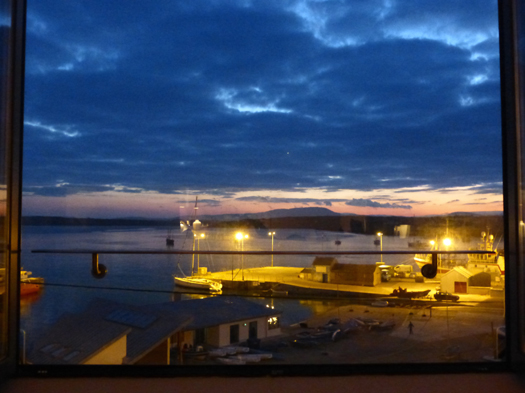
The view from Room 12 at the Waterfront in Baltimore. The sun has set beyond Mount Gabriel, but somebody is busy launching a newly-arrived RIB by floodlight, and the buzz from the square below is still rising. Photo: W M Nixon
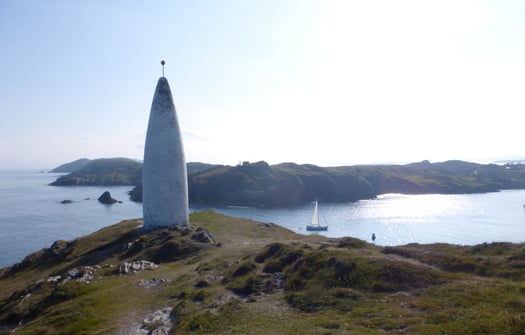
It has to be one of the best arrivals in world sailing. A cruiser enters Baltimore beneath the Baltimore Beacon, aka Lot's Wife. Photo: W M Nixon
It was fifty years ago when I first sailed in to Baltimore, coming in from the west on a round Ireland cruise, and entering port close under the beacon – Lot's Wife they call it – to find a quiet little place which showed some signs of a former prosperity, and hinted at better times to come. Back in 1964, it still had its railway station, but the West Cork Line was in its final year and was soon to be totally closed. Before that happened, later that summer when Baltimore Sailing Club hosted Dinghy Week for the Irish Dinghy Racing Association, the Firefly Class in Dun Laoghaire – mostly university boats – had been able to have a Tuesday night race. Then they'd towed their boats into Dun Laoghaire station on the launching trolleys, put them onto a CIE flat truck, and found them on Friday night safely delivered by rail the entire way to West Cork, offloaded ready at the harbourside station in Baltimore, and waiting for the arrival of thirsty crews keen for a bit of sport.
Mostly, they'd got themselves there by overloading some little car belonging to somebody or other's mother, so the fact that they disdained to use the railway themselves would help to explain why such a charming amenity was doomed. Since then, of course, Baltimore Railway Station from 1969 until recently had become Ireland's first Glenans base. But life moves on, the Glenans model doesn't seem to work any more in Ireland, so now the former station is for sale by the powers-that-be, and there are ructions being raised about it all which should keep everybody nicely exercised through the rest of the summer.
It was another French import which currently sets the pace in Baltimore. Around 1980 a young Breton fisherman, Youen Jacob, came into the harbour, and in time he settled there. To say that Youen Jacob has played a major role in Baltimore life is understating the case. It is he and his family who have developed the Waterfront – quite a challenge in somewhere as conservative as West Cork – and with Youen Jnr's Jolie Brise restaurant and guest house beside it to provide an alternative aspect of good Breton cuisine, the Jacob family's establishments have given a healthy new configuration to Baltimore's miniature harbourside square, and have settled in so well you could be forgiven for thinking the little town was built around them.
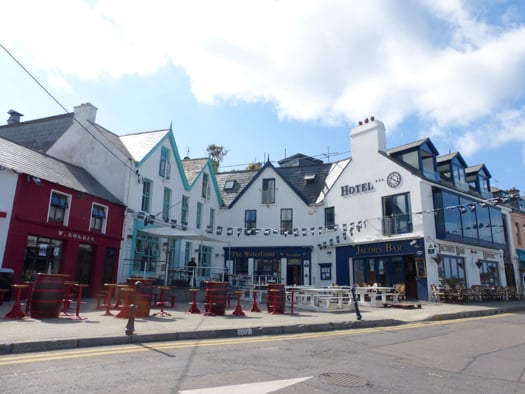
The Waterfront (right) and Jolie Brise at the south side of the mini-square in Baltimore bring a welcome breath of Brittany to West Cork. Photo: W M Nixon
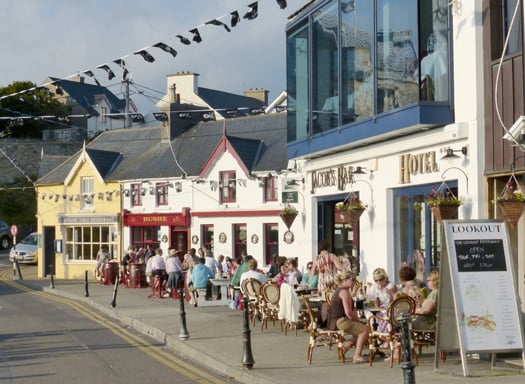
It's party time in Baltimore. The al fresco lifestyle is expected in West Cork in summer. Photo: W M Nixon
There are times when you'd understandably think this is the hub of the maritime universe, and why not? But if, during a quiet cruise, you think you might find it too hectic at night when the joint really is jumping, the sensible thing is to call by at lunchtime when everybody is out at the islands and Baltimore is refreshed and catching its breath for the next night's partying. Then in the evening, you can pop over to Sherkin Island where peace will reign while Baltimore ramps up the socializing.
Up in our eyrie above the square, we savoured the life of this busy little port. It's not quite a 24-hour town, but late at night boats were still being launched by floodlight, and conviviality continued in the square. Finally, peace descended, and though most folk were slow to stir early in the morning, the first ferries were coming in, and a workboat headed out for the islands, going past Graham Bailey's Peel Castle, the remarkable bisquine-rigged variation on a 50ft 1929-built Cornish lugger which is seen at her best on her mooring in Baltimore harbour. This is only right and proper, as the restoration and re-configuration of Peel Castle took place nearby, just up the Ilen River at one of the boatyards at Oldcourt.
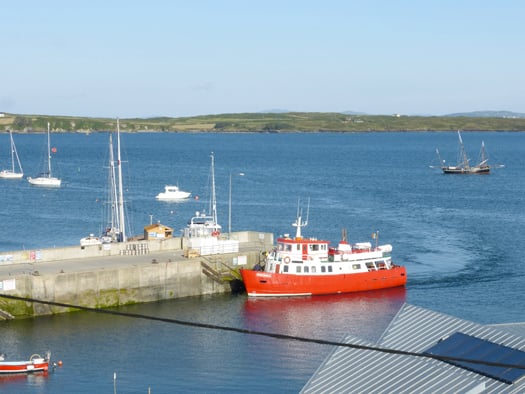
Good morning Baltimore, how are you? The first ferry arrives in from Sherkin Island. Photo: W M Nixon
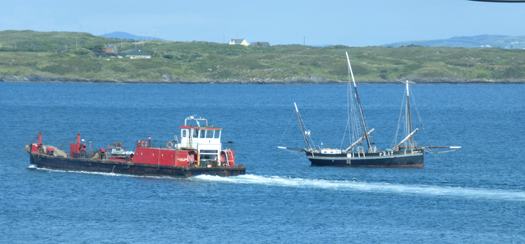
Getting the day's job started. A workboat heads out towards Sherkin past Graham Bailey's distinctive Peel Castle. Photo: W M Nixon

Peel Castle in all her glory in the middle of Baltimore Harbour. Restoring this 1929-built 50ft Cornish fishing boat and giving her a bisquine rig took Graham Bailey eight years of dedicated work at Oldcourt. Photo: W M Nixon
Another Baltimore revival which gets our approval is the restoration of the castle right in the middle of town, the "tigh mor" which presumably gives the place its name. We suffer from a widespread ruins overload in Ireland, so it's refreshing to find that somebody upped and took action, brining a ruin back to life and giving Baltimore a very effective signature focal point with a useful function. You could do the same to good effect at Dromineer on Lough Derg, where the ruined castle is an eyesore.
But you don't even have to leave the Baltimore area for a worthwhile restoration project, as just across the harbour beside the pier on Sherkin is the roofless ruin of the 15th Century Franciscan friary which we know looks much better with its roof back on, even if it has been missing since the 1770s.
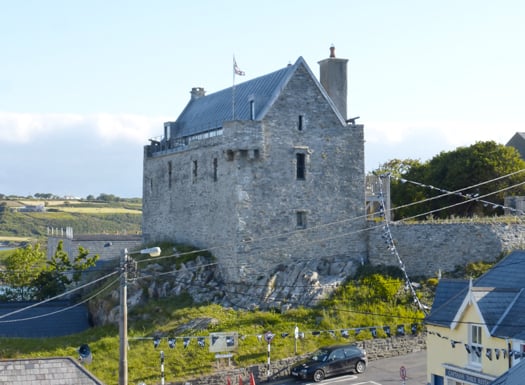
The restoration of the castle at Baltimore has given welcome and useful new life to a former ruin. Photo: W M Nixon
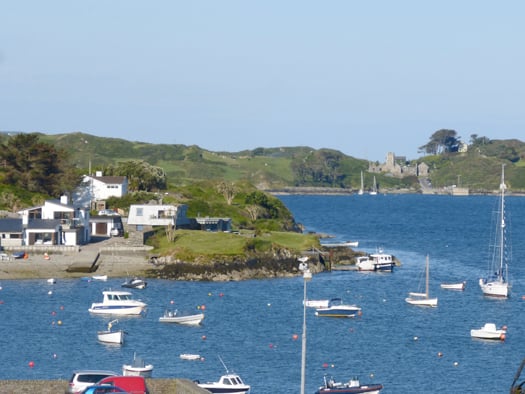
The Cove on the south side of Baltimore Harbour has some very desirable real estate. Photo: W M Nixon
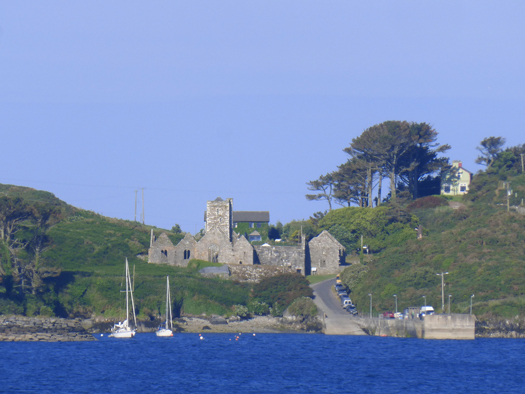
Thanks to its use as a film set in 1973, we know that the friary on Skerkin Island looks much better with it roof in place. Photo: W M Nixon
We know this because, in 1973, the makers of a TV film managed to get permission from the OPW to put a temporary but very convincing roof in place, and it looked so utterly right. The film was the unfairly forgotten Catholics, based on the novel of the same name by Belfast-born Brian Moore, and memorably starring Trevor Howard as the troubled Father Abbot. Even in this usually overlong blog, there isn't space to go into the details of the story, but it's worth viewing Catholics at the very least to see how well Sherkin friary looks with a roof. Alas, when filming was done the production company religiously (how else?) adhered to the OPW's demands to return the very attractive little old building to its ruinous state, and there it sadly sits.
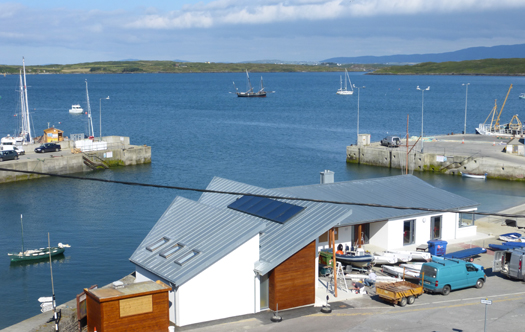
This year's work on Baltimore Sailing Club has made it even more of a local asset. Photo: W M Nixon
But as regular readers of Afloat.ie will know, other refurbishment and extension work has been under way in Baltimore, with the Sailing Club in fine fettle in its extended premises which look so well you'd think it's all new. It's certainly all of a piece with Baltimore's vitality, which contrasts with other little West Cork ports. In Baltimore, the key to it all is the fact that the Waterfront gallantly stays open all year round. But at present in Schull and Glandore, the main hotels don't even open in summer.
Doubtless in time, and sooner rather than later, both establishments will be brought back to life. But for people genuinely cruising, the absence of a hotel or two doesn't matter that much in an area where the abundance of cruising options and hospitable pubs with good food is almost bewildering. And around Baltimore in particular, there's always something going on.
The wholesome 1893-built cutter Eva (later known as Guillemot) was restored at Oldcourt, which is only a few miles from her birthplace 121 years ago on the Baltimore waterfront. Brian Marten's project to have Eva re-born and continue as Guillemot has come to a successful conclusion after she went through several vicissitudes before he happened upon her, but a visit to Oldcourt will reveal many other boat restoration, re-build and re-birth projects at various stages, including some which - as our accountancy friends would insist on putting it - are no longer going forward.
Be warned, however, that any visit to Oldcourt in any capacity whatever is likely to take longer than you expect, as there's simply so much to see. And they're at every stage, from projects just starting, through projects stalled, to projects nearing completion, while inspiration was being provided by a visiting boat, Darryl Hughes' immaculately-restored 1937 43ft Tyrrell ketch Maybird, which was berthed for a while at Oldcourt to let boatbuilder John Hegarty take off measurements in order to build a traditional clinker dinghy which will fit on board.
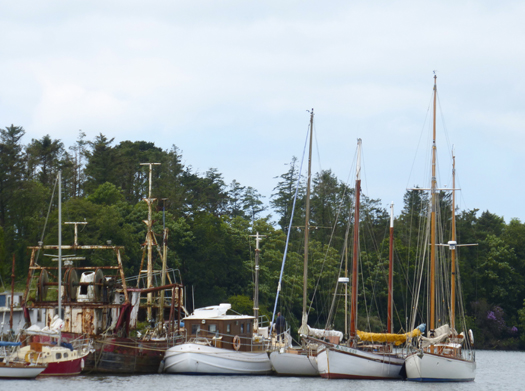
Boats in a row at Oldcourt. The further from the quay, the more ready for sea you are. Furthest out is the 1937 Tyrrell ketch Maybird, with which owner Darryl Hughes regularly attends the annual Yeats Summer School in Sligo. He's the only participant to arrive by sea, and he lives on board at the pontoon in Sligo during the Yeats festival. Photo: W M Nixon
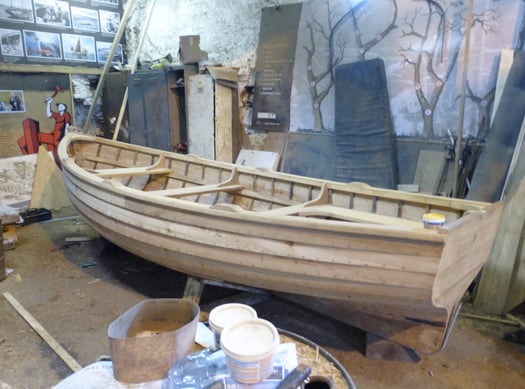
A new traditional clinker dinghy, built by John Hegarty of Oldcourt, awaits her first coast of varnish. Photo: W M Nixon
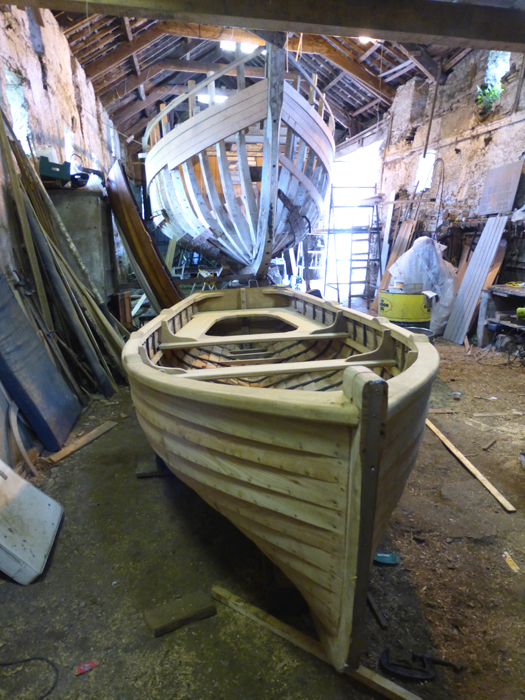
The new dinghy shares space with Conor O'Brien's Ilen, which continues to be a major work in progress. Photo: W M Nixon
Just to show what the result will be like, there was another recently-completed Hegarty dinghy in the Ilen shed, and very well it looked too. As for the restoration of Conor O'Brien's Ilen herself, that can best be described as ongoing. It has become such an absorbing task that the restoration process might best be thought of as an end in itself. Trying to work out what could most usefully be done with this hefty big lump of a boat if she ever is restored to seagoing condition is something which will require many brainstorming sessions, but it surely doesn't need to be considered in too much detail just yet.
The problem with the Ilen is she's too small for some things, and too big for others. She's of the same sort of in-between size which made the first Asgard of limited use as an official sail training vessel. Asgard was fine for teaching young people to sail, but she was simply too small to keep up with the tall ships which also completely overshadowed her in port, where Ireland's little ketch also failed to provide the necessary space and impressive setting for entertaining local bigwigs.
Manageability is the keynote to successful boat restorations. But Oldcourt is such a maritime universe that it can provide examples of what you'd think might have been eminently manageable restoration projects, yet they've ground to a halt. One such is Englyn, the creme de la crème of the boats amateur-designed by Harrison Butler, the English opthalmologist. In the 1930s, he was designing boats which successfully anticipated the highly-regarded designs of Lyle Hess more than forty years later, and the 26ft 6ins Englyn was so highly thought of by cruising guru Eric Hiscock that he included the design in his seminal book Cruising Under Sail, first published 1950.
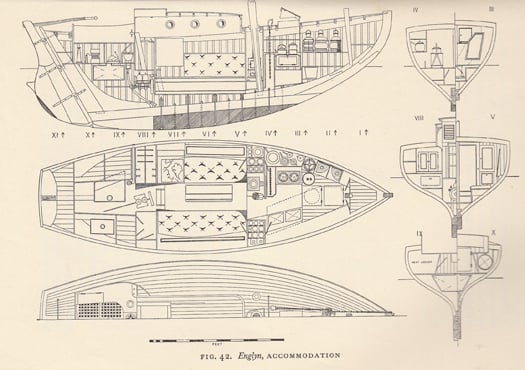
Plans of the Harrison Butler-designed Englyn, as featured in Eric Hiscock's Cruising Under Sail.
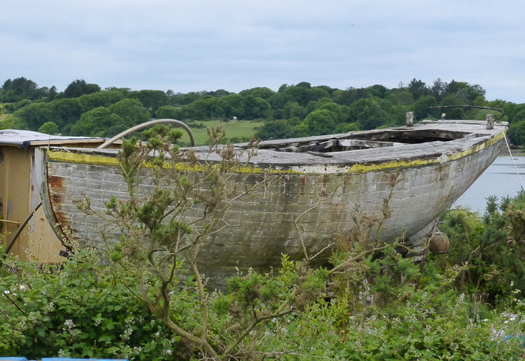
A little boat that may have missed the boat. Englyn as she is today. Photo: W M Nixon
If anything, the designs of Harrison Butler are more cherished than ever, and in this blog on May 10th we featured photos of the Harrison Butler Khamseen class cutter which ace boatbuilder Steve Morris is creating near Kilrush. It's heart-breaking to see the lines of Steve's healthy boat palely reflected in the weather-beaten remains of Englyn as she is today. But sometimes boats really can be brought back from the near-dead, and at the two-day Glandore Classic Boat Summer School in mid-July, the entire Sunday afternoon was given over to presentations about boats in various stages of restoration in and around Oldcourt.
Despite some unpleasantnesses visited upon it by the lingering death of the Celtic Tiger, Glandore gallantly soldiers on. Glandore Harbour Yacht Club's new headquarters in a cleverly rebuilt two-storey cottage up a side street (the only side street, as it happens) is appropriate to the good taste which prevails in this sweet place, whose name in Irish can mean either the golden harbour, or the harbour of the oaks - either will do very nicely.
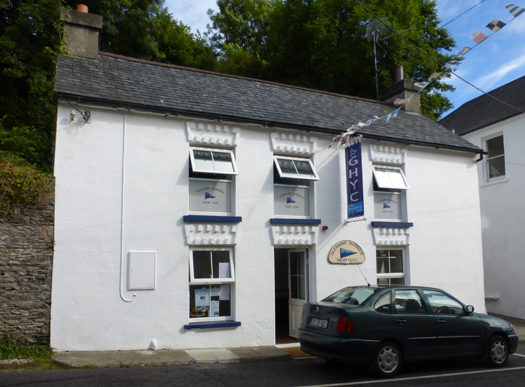
Glandore Harbour YC's clubhouse is now this cleverly re-built two-storey cottage beside the harbour. Photo: W M Nixon

The outboard dinghies waiting at the pontoon at Glandore Pier give a good indication of the number of boats based in Glandore and across the harbour at Union Hall. Photo: W M Nixon
The Summer School packed in an extraordinary variety of topics, and even this blogger was wheeled out to develop his thesis based around the ambiguous question: Why shouldn't the Irish be a seafaring people? Don't worry, for those who missed it, we'll push it out again here some time in the depth of winter. But we cannot hope to convey the full wonder of the best event in the Summer School, the question-and-answer session between ocean voyaging and offshore racing legend Don Street and his son Richard.
The old boy hasn't half been around. And if at some time your only experience of Don Street has been a high-pitched New England rant about some iniquity of modern yachting (fibreglass dismissed as "frozen snot", for instance) it's my happy duty to assure you that, as he delved into his extraordinary memories, the pitch of Don Street's distinctive voice became deeper and more resonant, until by the time he concluded all too early, we could have been listening to Captain Ahab himself.
From such a treasure trove of recollection, there were many gems, perhaps the best being about how he came to make his profession in writing about the sea and sailing. In his early days in the Caribbean before he'd put pen to paper, on one run ashore Don and his shipmates met up with Nobel Laureate John Steinbeck, and they'd a convivial time together. Later, heading back along the islands, they'd another dinner with the great writer, and during yarning at table, Don's shipmates insisted he'd so many good stories to tell that he should write them down.
"But I don't know how to spell, and I know nothing about grammar" complained Don.
"But you've a story to tell" said Steinbeck, "and you tell it well. Just you write it down, and the editors will sort out the spelling and the punctuation and the grammar. That's their job."
God be with the days......
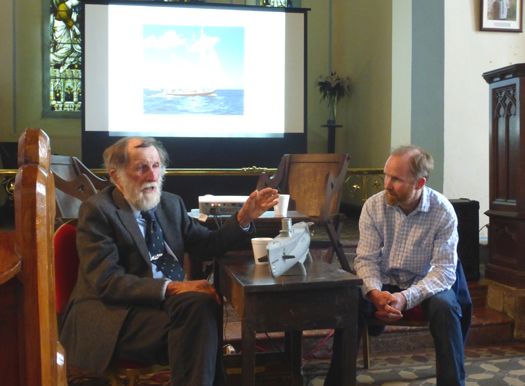
The old man of the sea – Don Street's reminiscences were the highlight of this year's Glandore Classic Boat Summer School. The school sessions were held in the harbourside church, and Don is seen here with his son Richard while he recalls his days in submarines in the US Navy. On the screen is his legendary 1905-built yawl Iolaire, in which he cruised the Caribbean and crossed the Atlantic. Photo: W M Nixon
Baltimore Sailing Club's Refurbished Clubhouse Opens
#baltimore – The village of Baltimore in West Cork was en fête yesterday (20th July 2014) with the opening of the newly-rebuilt clubhouse for Baltimore Sailing Club by Simon Coveney TD, Minister for Agriculture, Food, the Marine & Defence.
The opening follows a proposed Fáilte Ireland sale of the former Glenans sail training school premises in the West Cork town.
As Afloat.ie reported in April the new West Cork club house has been greatly welcomed by Irish sailing and yesterday, the scenic fishing village played host to hundreds of local and national sailors, visitors to the region and the local community, who were hugely supportive of the development of new Clubhouse and its facilities, which embraces all levels of sailing and encourages activity in the waters of the Carbery's 100 isles surrounding Baltimore. St. Fachtna's Silver Band from Skibbereen added to the carnival atmosphere, performing in the open air, with the stunning backdrop of Baltimore and the islands behind and boats of all shapes and sizes rafted up to complete the picture.
Minister Coveney stated: 'Baltimore is a very special place in West Cork, and the vibrancy is palpable from the moment one arrives here. There is an obvious high level of co-operation between the various groups in the village and its hinterland, culminating in the re-building of this impressive structure, offering outstanding facilities for locals and visitors. The Government and its agencies including West Cork Development Partnership, and Cork County Council, are delighted to lend support to the project, in the knowledge that it is significantly improving marine infrastructure in Baltimore. The Government has also supported the building of the new pier and service buildings in Baltimore, and I feel sure that, in the future, this harbour will see many new developments for the better in this wonderful part of west Cork'.
'This project is a testament to a fantastic volunteer effort by our members, supported by the people of Baltimore, and supporters and friends from many walks of life. In particular I'd like to pay tribute to Tony O'Driscoll, my predecessor as Commodore of the Club, whose relentless enthusiasm and hard work saw this project cross the line in jig time.' said Joan Collins, Commodore of the Baltimore Sailing Club.
Joan added: 'Baltimore has retained its friendly village atmosphere and this new clubhouse adds to the offering, with year round activity to encourage people to get on the water and enjoy the freedom of the waters of West Cork. The re-furbishment will be a great boost for our sailing fraternity, and we now have an option to host our events with style, while encouraging additional events which can only be of definite benefit to the Baltimore and greater West Cork area.
The Club is a vibrant and active summer club and has, and will, host several prestigious sailing events. With sailing every weekend throughout the summer and additional events out of season including at Easter (Laser Munsters), the National 18ft Class over June bank holiday weekend this year, and the Optimist Coaching week in February, we will hold many other great events later this year.'
Designed by architect John McCarthy and built by local builder, Michael Joe Leonard, the new Clubhouse space incorporates enhanced facilities for members and visiting sailors, including a new shower block (15 showers) and spaces facilitating events, training, seminars and storage and improved dingy parking. Totally transformed, and re-built at a cost of €400,000, the Club was supported by Cork County Council and West Cork Development Partnership, with match funding provided by the Club itself and by donations from members and the general public. Founded in 1952, Baltimore Sailing Club has over 600 members drawn from the locality and other regions, including several overseas members.
Baltimore is renowned for its sailing courses for children of all levels (85 children availing of this currently), and the Rambler Team Racing for junior club members is very popular again this year. Junior sailors from Crookhaven, Schull, Glandore and Baltimore are also involved in the inter-club Marconi Cup team racing event bringing communities closer together in the region. There is a course for adults in train this year also, and it is hoped to build on this offering into the future.
Sailing events in Baltimore include Baltimore Sailing Club Regatta will take place over the August bank holiday weekend, as will the 1720 Club. The inaugural WOMEN ON THE WATER (WOW) event on August 12th in aid of Breakthrough Cancer Research (part of Cork Cancer Research Centre) will see craft of all shapes and sizes on the water, with onshore fun for all the family. Sponsorship cards are available at the clubhouse and Commodore Collins is confident this event will raise a substantial amount for cancer research.
The Club will also participate in Bart's Bash, one of the first clubs in Ireland to register for this massive world-wide charity event. The clubhouse will also be used by local organisations such as the Baltimore Bridge Club, RNLI, local festival groups and defibrillator personnel, truly embracing all strands of society in the area.
#Tourism - A Baltimore maritime group says Fáilte Ireland's commitment to coastal tourism "rings very hollow" in light of its proposed sale of the former Glenans sail training school premises in the West Cork town.
Last September Afloat.ie reported on the decision by the French sail training group, one of the biggest such operators in Ireland, to close its bases at Collanmore and Baltimore.
The Baltimore location had operated since 1969 in a redbrick building that was once the southern terminus of the Skibbereen branch line, according to The Irish Times.
But Fáilte Ireland, which took over ownership of the waterfront property from Cork-Kerry Tourism, is "determined to put the station and allied facilities ... on the open market" for sale to to the "highest bidder", says Micheál O'Meara, chair of the Baltimore Maritime Centre/Glenua sail training group.
O'Meara adds that the decision flies in the face of Fáilte Ireland's commitment to the Wild Atlantic Way initiative, as the Old Station House "is a key anchor of the project" with potential to provide maritime education and training alongside sailing courses.
The Irish Times has more on the story HERE.
#Diving - RTÉ News is reporting on a major search and rescue operation for a missing diver after another was airlifted to hospital from the West Cork coast this morning (Wednesday 2 July).
It's thought that the two were diving at a wreck site off Baltimore when they got into difficulty. The condition of the hospitalised diver is not yet known.
Update 12.01pm: RTÉ is now reporting on Twitter that the hospitalised diver has died. The search continues for the missing diver.





























